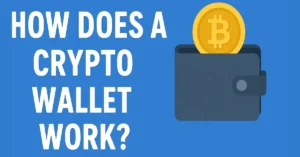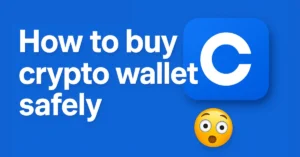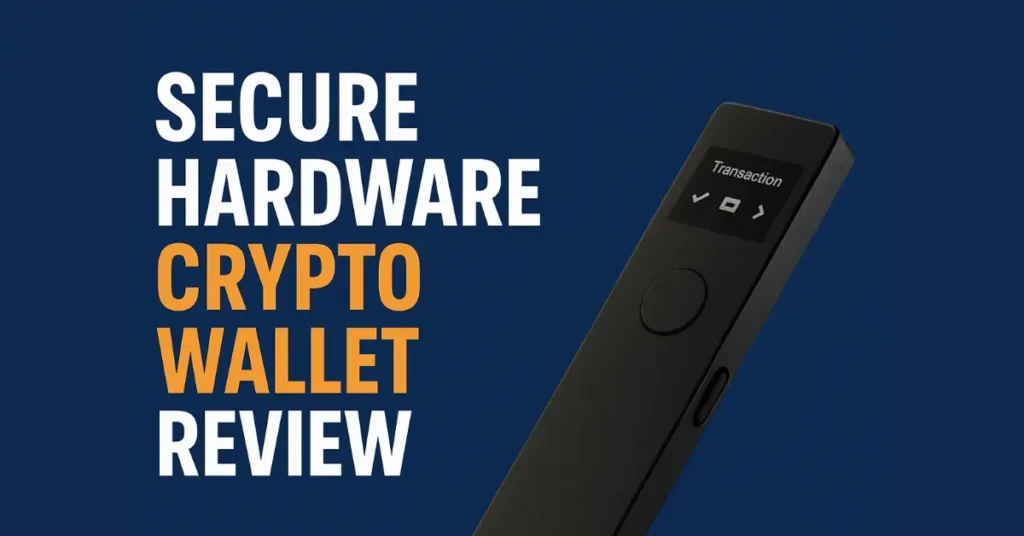Secure hardware crypto wallet review
Introduction
Cryptocurrency has taken the financial world by storm, transforming how people think about money, payments, and investments. But with great opportunity comes great responsibility—especially when it comes to securing your digital assets. Every day, millions of dollars in crypto are lost to hacks, phishing scams, and poorly protected wallets. If you’ve ever left your coins sitting on an exchange or relied solely on a mobile app wallet, you’ve probably worried about what would happen if the platform got hacked or your phone got stolen. That’s where secure hardware crypto wallets come in.
Unlike hot wallets that stay connected to the internet, hardware wallets store your private keys offline, making them far less vulnerable to cyberattacks. Think of it as the digital equivalent of a fireproof safe for your crypto. This article will provide an in-depth review of the most secure hardware wallets in 2025, break down their features, compare them, and share practical tips on how to use them safely. Whether you’re a beginner buying your first Bitcoin or a seasoned investor managing a multi-coin portfolio, this guide will help you make the right choice.
Why You Need a Secure Hardware Wallet
If you’ve been in the crypto space for a while, you’ve probably heard the phrase “Not your keys, not your coins.” It’s a reminder that leaving your funds on an exchange means you don’t own them—the exchange does. This has proven disastrous countless times, from the infamous Mt. Gox collapse to recent exchange bankruptcies. When exchanges get hacked, users often lose everything.
Even hot wallets, like mobile or desktop apps, come with risks. While convenient, they are constantly connected to the internet, making them a prime target for hackers and malware. Imagine leaving your front door unlocked in a neighborhood full of burglars—that’s essentially what using a hot wallet feels like.
A hardware wallet eliminates most of these risks. It stores your private keys in a secure, offline device that hackers can’t reach remotely. Even if your computer is infected with a virus, your funds remain safe because transactions must be confirmed physically on the device itself. For long-term holders, high-net-worth investors, or anyone serious about crypto security, a hardware wallet isn’t just recommended—it’s essential.
How Hardware Wallets Work
At first glance, a hardware wallet might look like a USB stick or a small gadget with a screen. But inside, it’s a security powerhouse. The key idea is cold storage—keeping your private keys completely offline, away from hackers and spyware.
Here’s a breakdown of how they work:
- Private Keys & Seed Phrases: Your wallet generates a seed phrase (usually 12–24 words). This phrase is like a master key to all your crypto accounts. As long as you have this seed phrase, you can recover your funds—even if the wallet is lost or destroyed.
- Transaction Signing: When you want to send crypto, the transaction is prepared on your computer or phone, but it must be approved on your hardware wallet. This means your private keys never leave the device.
- Connection Methods: Some wallets connect via USB, while newer ones offer Bluetooth or QR-code scanning for mobile use. The important part is that the signing process happens securely inside the wallet.
- Security Chips & Encryption: Most reputable wallets use a Secure Element (SE) chip, the same type used in passports and credit cards, to protect your keys from physical attacks.
This system makes it nearly impossible for hackers to steal your funds remotely. The only real threats come from poor user practices, like losing your seed phrase or buying from shady resellers.
Factors to Consider Before Buying a Hardware Wallet
With so many wallets on the market, how do you pick the right one? It’s tempting to just buy the cheapest option, but not all wallets are created equal. Here are the key things to consider before making your choice:
- Security Features – Look for PIN protection, optional passphrases, two-factor authentication, and support for advanced setups like multisignature wallets.
- Supported Cryptocurrencies – Some wallets only support Bitcoin and Ethereum, while others handle thousands of coins and tokens. Make sure the wallet supports the assets you hold.
- Ease of Use – If a wallet is too complicated, you might avoid using it correctly—or worse, make mistakes that cost you money. Beginners may prefer wallets with touchscreen displays and simple setup guides.
- Backup & Recovery Options – A strong backup system is critical. Check how the wallet handles recovery phrases, and consider whether you can store them safely.
- Price vs. Features – Entry-level wallets start at around $50, while advanced ones can go up to $300 or more. The most expensive wallet isn’t always the best—balance the cost with what you need.
By weighing these factors, you can choose a wallet that balances security, convenience, and price, tailored to your needs.
Top Secure Hardware Wallets in 2025 – Full Review
Now that we understand why hardware wallets are essential, let’s dive into the top options available in 2025. Each wallet has its strengths and weaknesses, so the “best” one depends on your personal use case.
Ledger Nano X
The Ledger Nano X is one of the most popular wallets on the market, offering Bluetooth connectivity and support for over 5,000 cryptocurrencies. It’s compact, portable, and integrates smoothly with Ledger Live, making it ideal for users who want mobility without sacrificing security. However, its price point is higher than some competitors, and Bluetooth raises minor security concerns for ultra-cautious users.
Trezor Model T
Trezor has been around since the early days of crypto, and the Model T is its flagship wallet. It features a full-color touchscreen, open-source firmware, and top-notch security. Many advanced users love Trezor for its transparency, but beginners might find it a bit intimidating at first.
Ledger Nano S Plus
If you want Ledger’s security without the higher cost of the Nano X, the Nano S Plus is a great choice. It lacks Bluetooth but supports the same wide range of coins. It’s a solid entry-level wallet, though its smaller screen makes navigation slightly less convenient.
Ellipal Titan
The Ellipal Titan is unique because it’s completely air-gapped—meaning it never connects via USB or Bluetooth. Instead, transactions are signed via QR codes. This makes it one of the most secure wallets against remote attacks, though it can feel slower to use.
SafePal S1
Designed for mobile-first users, SafePal S1 offers strong security features at an affordable price. It also uses QR-code signing, making it resistant to USB and Bluetooth vulnerabilities. It’s beginner-friendly and a great balance of price and function.
Other Notable Mentions
- Keystone Pro – Great for multisig setups
- BitBox02 – Minimalist design, Swiss-made security
- Coldcard Mk4 – Bitcoin-only wallet with advanced security features
In-Depth Comparison of Hardware Wallets
When it comes to choosing a hardware wallet, there’s no one-size-fits-all answer. Each device comes with its own blend of features, security standards, and usability factors. A beginner with a small crypto portfolio may not need the same level of functionality as an advanced trader managing multiple assets. To help simplify the decision-making process, let’s compare the leading wallets side by side.
| Wallet | Price (Approx.) | Supported Coins | Best Feature | Ideal For |
|---|---|---|---|---|
| Ledger Nano X | $149 | 5,000+ | Bluetooth, Ledger Live app | Active traders, mobile users |
| Trezor Model T | $219 | 1,200+ | Touchscreen, open-source | Transparency-focused users |
| Nano S Plus | $79 | 5,000+ | Budget-friendly | Beginners, long-term holders |
| Ellipal Titan | $169 | 10,000+ | Air-gapped, QR transactions | Security-first investors |
| SafePal S1 | $50 | 30,000+ | Mobile-first, affordable | New investors, budget users |
From this breakdown, you can see that the Ledger Nano X is a powerhouse for those who want versatility and mobile connectivity. On the other hand, the Ellipal Titan stands out for extreme security since it operates without USB or Bluetooth—perfect for those who prioritize safety above speed.
Meanwhile, the SafePal S1 punches far above its weight in terms of value, supporting tens of thousands of tokens at just a fraction of the cost of its competitors. If you’re managing DeFi tokens and don’t want to overspend, this wallet makes sense.
Ultimately, the “best” wallet depends on your usage. If you’re buying Bitcoin as a long-term store of value, the Ledger Nano S Plus or Coldcard (Bitcoin-only) will do the job. But if you’re diving into altcoins, NFTs, or DeFi, something like Ledger Nano X or Ellipal Titan may serve you better.
Pros and Cons of Using Hardware Wallets
Like any tool, hardware wallets come with strengths and weaknesses. They’re not magic devices that guarantee complete safety, but they dramatically reduce risks compared to leaving your crypto in hot wallets or exchanges.
Pros:
- Offline Security: Your private keys never touch the internet, drastically lowering hacking risks.
- Ownership: You have full control—no third-party custody involved.
- Compatibility: Many hardware wallets integrate with DeFi apps, DEXs, and NFT marketplaces.
- Portability: Small and discreet, hardware wallets are easy to store or travel with.
- Backup & Recovery: Even if the device is lost, you can recover funds using your seed phrase.
Cons:
- Cost: Unlike free hot wallets, hardware wallets can cost between $50–$300.
- Learning Curve: Beginners may feel overwhelmed setting up and managing seed phrases.
- Physical Risks: If lost or stolen without backups, funds could be at risk.
- Updates Required: Users need to regularly update firmware for maximum protection.
- Limited Convenience: They’re less convenient than hot wallets for frequent trading.
For most people, the benefits far outweigh the downsides. The peace of mind you get from knowing your assets are safe is worth the cost and slight inconvenience. If you treat your crypto as an investment rather than a daily spending tool, a hardware wallet is easily one of the smartest purchases you’ll ever make in your crypto journey.
Setting Up a Hardware Wallet Safely
Setting up a hardware wallet isn’t complicated, but it’s where many people make critical mistakes. Think of this process like installing a security system in your home—you want to get it right the first time.
Here’s a step-by-step guide to setting up most hardware wallets:
- Unbox the Device Carefully – Ensure it’s sealed and purchased directly from the official manufacturer or an authorized seller. Avoid second-hand purchases, as they may be tampered with.
- Initialize the Wallet – Power it on and follow the setup instructions. Never accept a pre-configured device with a seed phrase already included—it’s a red flag.
- Create a PIN Code – Choose a strong PIN to prevent unauthorized access if your wallet is stolen.
- Write Down Your Seed Phrase – You’ll be given a 12–24 word recovery phrase. Write it down on paper (or better yet, engrave it on a metal backup plate). Never take a photo or store it digitally.
- Confirm Seed Phrase – Most wallets require you to re-enter your phrase to ensure you wrote it correctly.
- Install Companion Software – Apps like Ledger Live or Trezor Suite let you manage coins, install updates, and connect with dApps.
- Make a Test Transaction – Always test with a small amount before transferring large funds.
By following these steps, you’ll drastically reduce the risk of mishaps. Remember: your seed phrase is the single most important piece of information. Treat it as you would the keys to your house or even your bank vault.
Common Security Mistakes to Avoid
Even the most secure hardware wallet won’t protect you if you fall into common traps. Many users unknowingly sabotage their security by cutting corners. Here are the most frequent mistakes to avoid:
- Buying from Unauthorized Sellers: Some people try to save a few bucks by buying used or discounted wallets from eBay or Amazon resellers. The danger? The device could be tampered with, exposing your funds. Always buy directly from the manufacturer.
- Ignoring Firmware Updates: Hackers constantly look for new exploits. If you don’t update your wallet, you’re leaving it exposed to vulnerabilities that could have been patched.
- Storing Seed Phrases Digitally: Taking a photo or storing your phrase in Google Drive may seem convenient, but it’s a hacker’s dream. Always keep it offline.
- Phishing Scams: Many fake websites mimic official wallet pages to trick users into entering their recovery phrases. Always double-check URLs before downloading software or entering information.
- Overconfidence: Some users assume that once they own a hardware wallet, they’re invincible. In reality, your security still depends heavily on your habits.
Avoiding these mistakes can mean the difference between securing your digital wealth for decades and losing it overnight.
Hardware Wallet Security Tips
If you’re serious about protecting your investments, there are some additional precautions you can take to strengthen your setup:
- Buy Only from Trusted Sources: Stick to official websites or verified retailers.
- Use a Metal Seed Storage Kit: Paper can burn or get water damage. Metal storage kits are fireproof and waterproof, ensuring your backup survives disasters.
- Enable Passphrase Feature: Many wallets allow you to add an extra word to your seed phrase. This creates a “hidden wallet” that only you know exists.
- Use Multisig for Large Holdings: With multisignature wallets, you’ll need multiple devices to sign a transaction, adding an extra layer of security.
- Keep Wallets Offline When Not in Use: Store them in a safe place, ideally a fireproof safe at home or a secure deposit box.
- Stay Private: Avoid bragging about your crypto holdings online. If someone knows you own a lot of crypto, you could become a target.
With these practices, you’re not just relying on the wallet’s built-in protections—you’re adding multiple layers of defense, much like locking your doors, installing an alarm system, and having a guard dog.
The Future of Hardware Wallets
Cryptocurrency continues to evolve rapidly, and so does the technology designed to protect it. Hardware wallets today are far more advanced than they were even five years ago, and the future looks even more exciting.
One of the biggest shifts we’re already seeing is integration with DeFi and NFTs. In the past, hardware wallets were primarily for storing Bitcoin and a few major altcoins. Now, they support thousands of tokens and even let users connect to decentralized applications (dApps) securely. Expect to see wallets that seamlessly integrate with DeFi platforms, allowing users to stake, swap, or farm tokens without ever leaving the security of their cold storage.
Another trend is multi-chain compatibility. With ecosystems like Ethereum, Solana, Cardano, and Layer 2 networks growing, investors no longer stick to one chain. Future wallets will need to support smooth cross-chain interactions so users can manage diverse portfolios from a single device.
Mobile-first design is also a major area of innovation. Devices like the SafePal S1 and Ellipal Titan are already pushing this trend by prioritizing mobile apps and QR-code transactions. As more people access crypto through their smartphones, hardware wallets will become even more mobile-friendly, possibly with biometric authentication features like fingerprint scanning.
Finally, there’s the question of regulation in the USA. As governments introduce clearer rules for digital assets, hardware wallet makers may be required to comply with new standards. This could mean features like built-in tax reporting or integration with regulated exchanges. While this might sound restrictive, it could increase adoption by making crypto feel safer and more accessible to the average American investor.
In short, hardware wallets will keep evolving from “simple vaults” to multi-purpose digital banks that protect, manage, and interact with your crypto assets.
Personal Insights and Recommendations
After reviewing the top wallets and exploring their strengths, let me share my take. If I had to pick one wallet for a U.S. audience, I’d recommend the Ledger Nano X for most users. It strikes the best balance between security, usability, and coin support. The Ledger Live app is polished and user-friendly, which is great if you’re just starting out but still want advanced features down the road.
For those who prioritize maximum security above all else, the Ellipal Titan is hard to beat. Its air-gapped design ensures your private keys never touch a cable, Bluetooth, or Wi-Fi signal. This wallet is ideal if you’re storing a significant amount of crypto for the long term and don’t mind sacrificing a little convenience.
On the other hand, if you’re on a budget but still want strong protection, the SafePal S1 is a hidden gem. At under $60, it gives you solid offline storage, mobile-first compatibility, and support for an incredible range of tokens. Beginners who don’t want to overspend will find this wallet especially appealing.
For Bitcoin-only purists, the Coldcard Mk4 is a clear choice. It’s not as beginner-friendly, but it offers some of the most advanced Bitcoin security features on the market.
Ultimately, the right wallet depends on your needs:
- Beginners & casual investors: SafePal S1 or Ledger Nano S Plus
- Active traders with diverse portfolios: Ledger Nano X or Trezor Model T
- Security-focused long-term holders: Ellipal Titan or Coldcard
Whatever you choose, remember that the wallet is just one part of the equation. How you handle your recovery phrase, update your firmware, and protect your physical device matters just as much as which brand you buy.
FAQs About Hardware Crypto Wallets
Are hardware wallets completely hack-proof?
No device is 100% hack-proof, but hardware wallets drastically reduce risks. They protect against remote attacks by keeping private keys offline. However, they can still be compromised if you fall for phishing scams or mishandle your seed phrase.
What happens if I lose my hardware wallet?
Your funds are not lost. As long as you have your recovery seed phrase, you can restore your wallet on a new device. This is why storing your seed phrase safely is absolutely critical.
Can I use multiple wallets at the same time?
Yes. Many investors use more than one hardware wallet to separate holdings or for added security. For example, one device could hold long-term investments while another is used for active trading.
Do I have to pay for wallet apps?
No. Official apps like Ledger Live or Trezor Suite are free to use. However, some third-party integrations may involve fees when interacting with DeFi platforms or exchanges.
Is it worth upgrading to a newer wallet?
If your current wallet is secure, supports your coins, and still receives firmware updates, you may not need to upgrade immediately. But if it lacks support for newer tokens or feels outdated, upgrading can give you access to better features and usability.
Conclusion
At the end of the day, crypto security boils down to one thing: control. A secure hardware wallet puts you in full control of your digital assets, shielding them from hacks, exchange failures, and online vulnerabilities. While there are plenty of options on the market, the choice ultimately depends on your needs and habits.
If you’re just starting, a budget-friendly wallet like the Ledger Nano S Plus or SafePal S1 can give you strong protection without breaking the bank. For those who want a premium experience with maximum versatility, the Ledger Nano X or Trezor Model T are top contenders. And if you’re focused on the highest level of security, the Ellipal Titan or Coldcard should be on your shortlist.
Remember, though, that the wallet is only as secure as the person using it. Avoid buying from unverified sellers, never store your seed phrase digitally, and stay alert for scams. With the right hardware wallet and safe habits, you can protect your crypto for years to come.
In the fast-moving world of digital assets, peace of mind is priceless—and that’s exactly what a secure hardware crypto wallet delivers.
Also, read
- What is a crypto wallet, and how does it work? – Coinsify
- 10 Crypto Terms Every Beginner Must Know: Coinsify
- What is blockchain technology? Complete Guide – Coinsify
- How to Buy Crypto Safely in 2025: Complete Guide – Coinsify
- Bitcoin vs Ethereum: Key Differences Explained: Complete Guide
- Ultimate Blockchain Glossary: Learn Blockchain Terms Easily
- How to Buy Bitcoin Safely (Complete Beginner’s Guide)
- Top 10 Crypto Wallets for Beginners (2025 Edition)
- What is cryptocurrency? A Beginner-Friendly Guide (2025)






